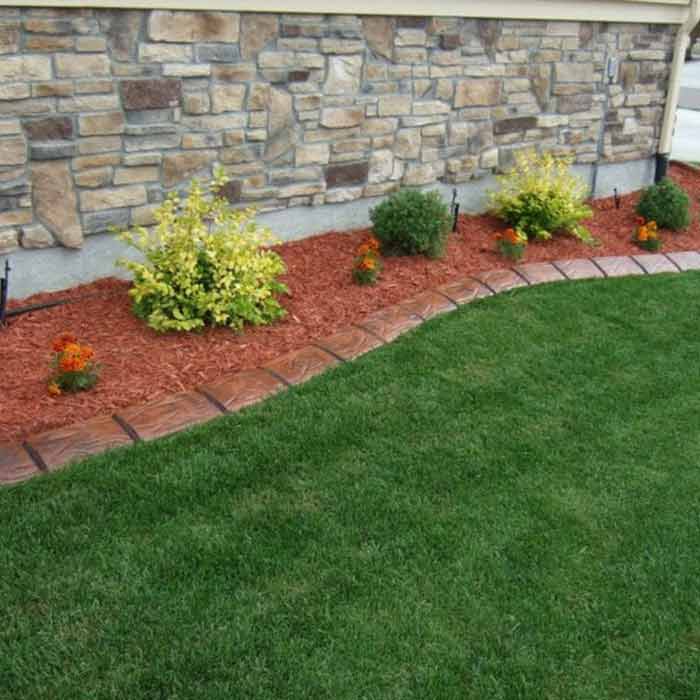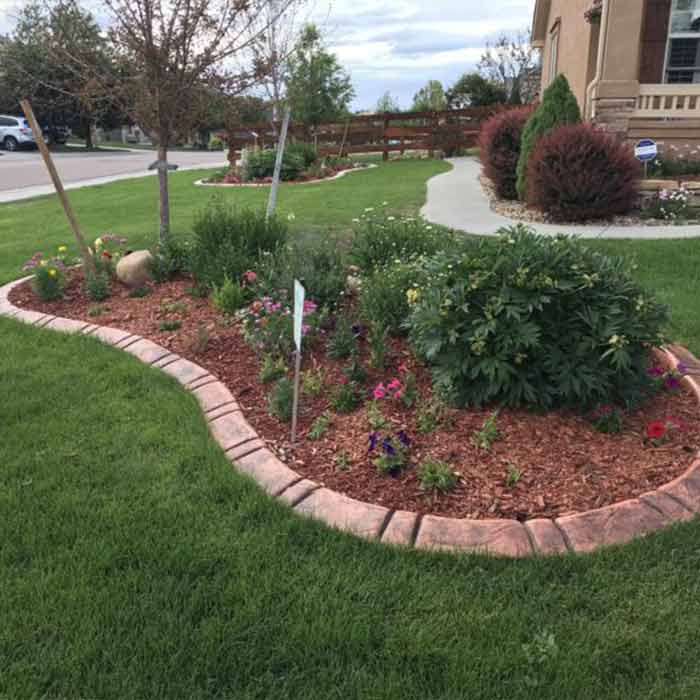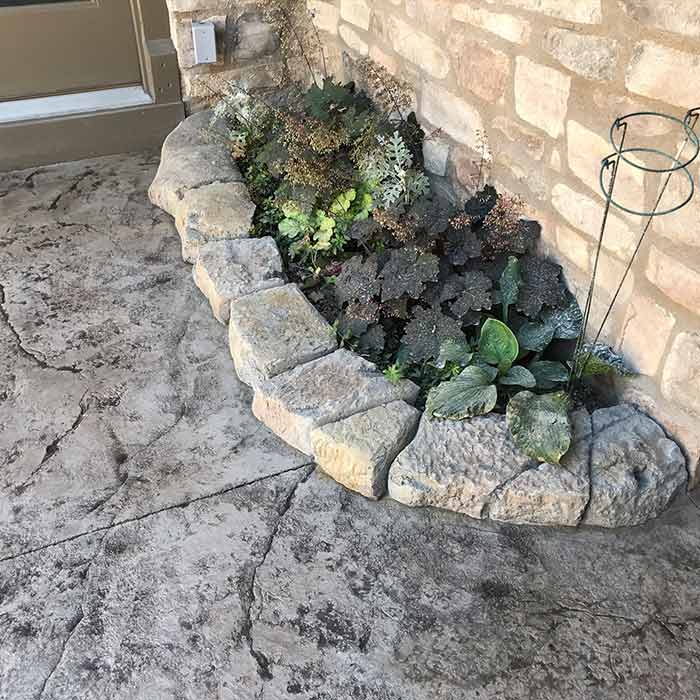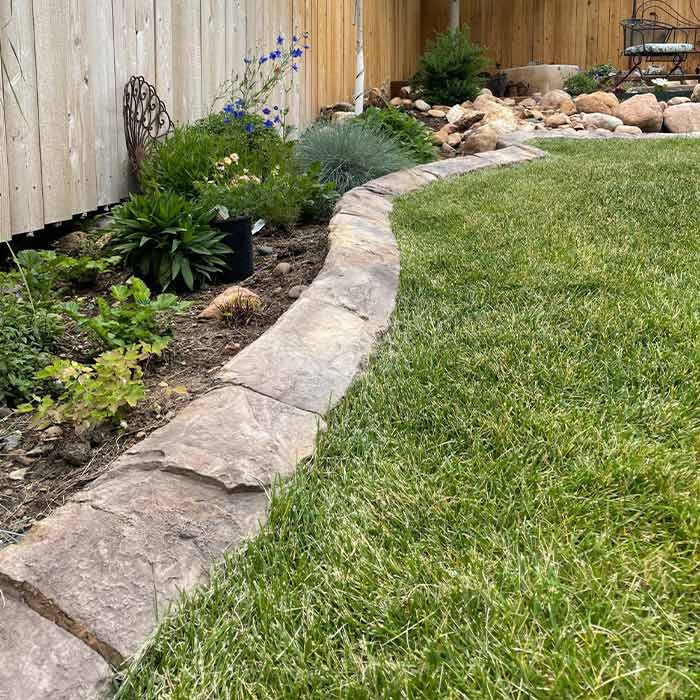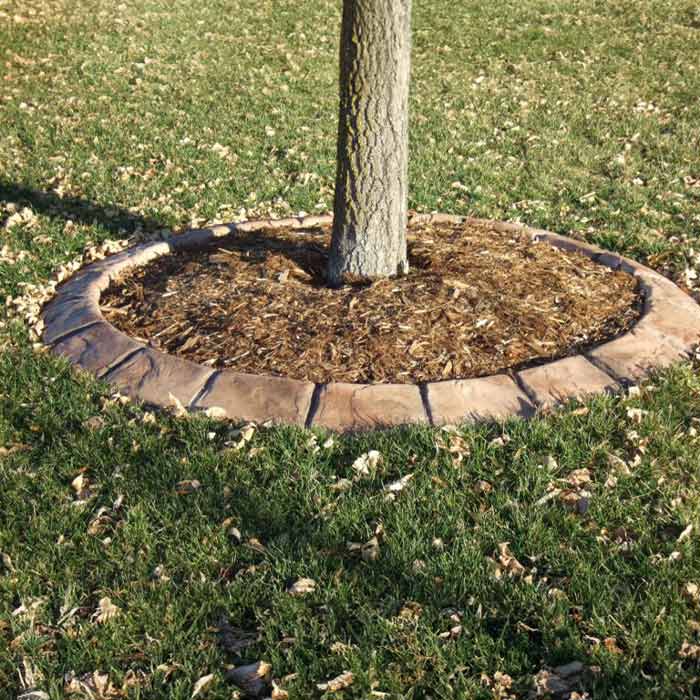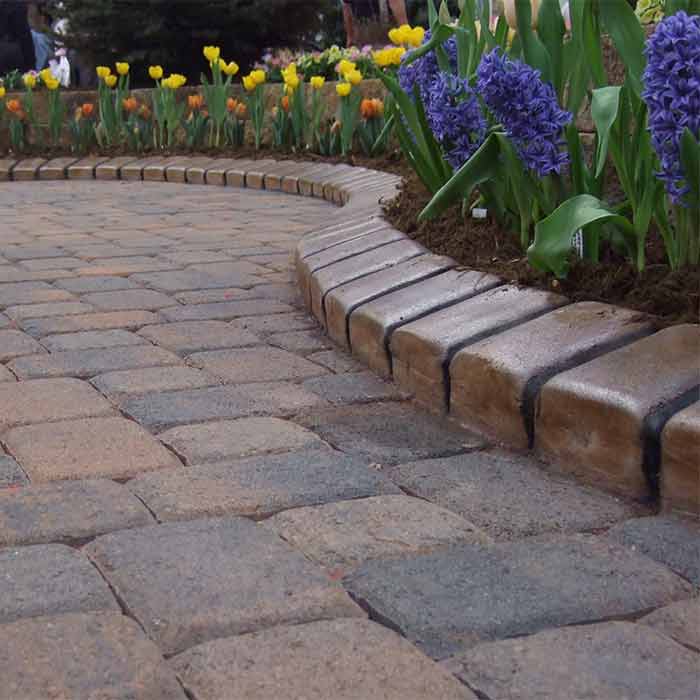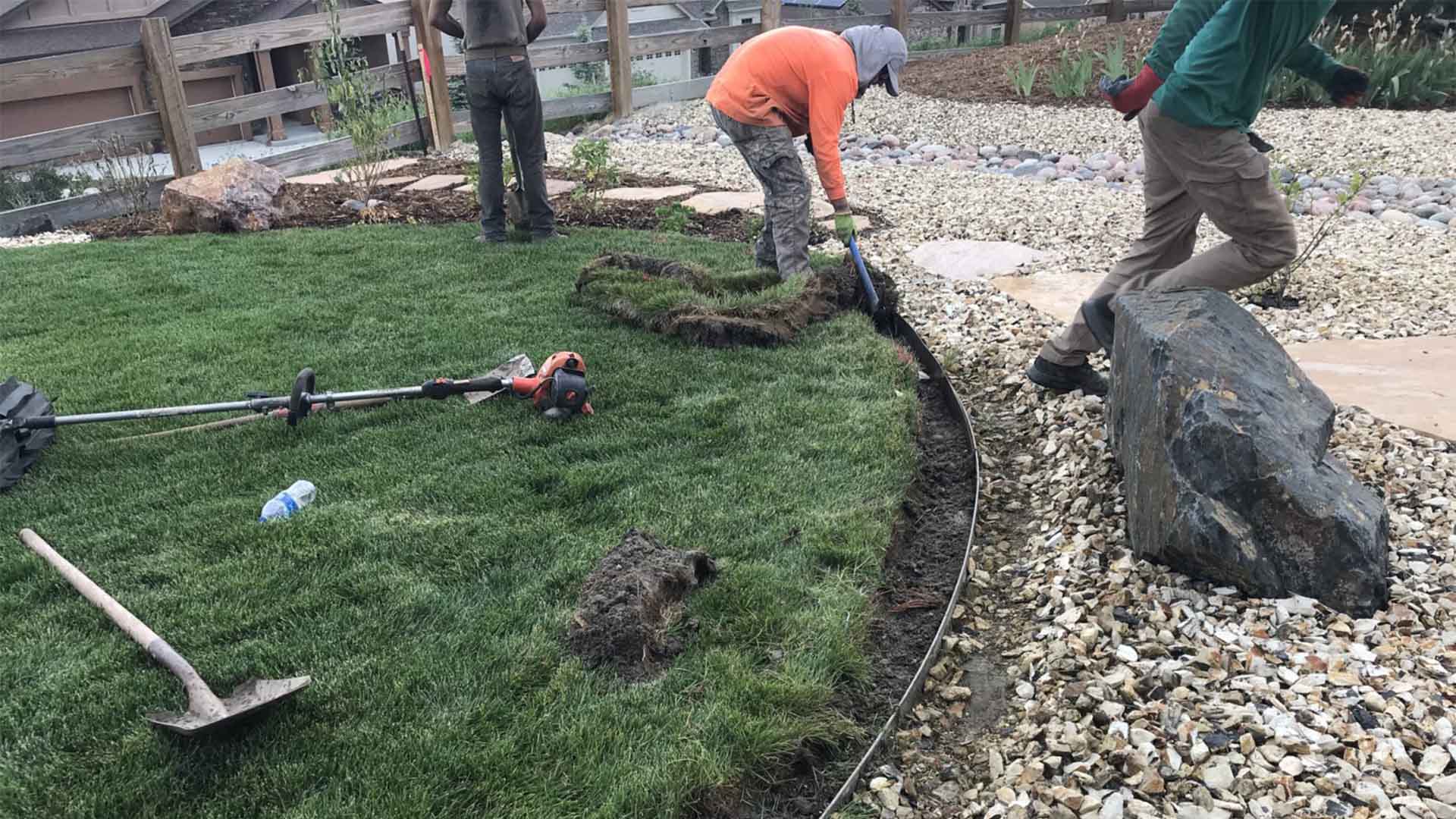Introduction to No-Dig Landscape Solutions
As a landscaping professional serving Colorado homeowners for over 15 years, I’ve witnessed firsthand how the proper edging can transform an ordinary yard into a stunning landscape. No-dig landscape edging has revolutionized how we approach garden borders, creating clean separations between lawn areas, flowerbeds, and hardscapes without the traditionally required extensive excavation. However, the durability of these solutions, up to 3-5 years, can affect the house’s look and performance.
No-dig landscape edging offers a quick, efficient alternative to traditional installation methods. It promises a professional finish without disrupting established root systems or requiring heavy equipment. But is it truly worth the investment? Let’s explore this affordable landscape solution’s advantages, limitations, and cost considerations.
What Exactly Is No-Dig Landscape Edging?
No-dig landscape edging refers to border materials that can be installed with minimal to no excavation. Unlike traditional edging that may require trenching 6-8 inches deep, no-dig options typically involve:
- Hammering stakes directly into the ground
- Securing edging materials to these stakes
- Creating a clean border without disturbing the underlying soil structure
This approach is particularly valuable for protecting established plants, preserving soil ecosystems, and creating immediate visual definition in your landscape.
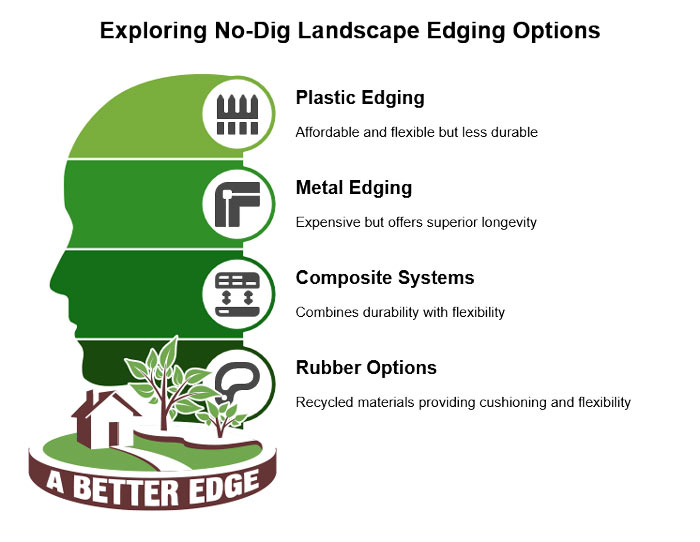
Common Types of No-Dig Landscape Edging
There are several varieties of no-dig landscape edging available, each with unique characteristics:
- Plastic No-Dig Edging: Affordable and flexible, though typically less durable
- Metal No-Dig Edging: More expensive but offers superior longevity and clean lines
- Composite No-Dig Systems: Combines durability with flexibility
- Rubber No-Dig Options: Recycled materials that provide cushioning and flexibility
Advantages of No-Dig Landscape Edging
Time Efficiency
The most immediate benefit of no-dig landscape edging is the dramatic reduction in installation time. While traditional edging installation might require several hours or even days, our solutions can often be completed in a fraction of the time, depending on the project scope.
“After installing both traditional and no-dig edging systems for over a decade, I’ve found that no-dig landscape options typically reduce installation time by 60-70% while delivering comparable visual results for most residential applications.” – Chad, Owner of A Better Edge
Plant Protection
Traditional edging installation requires significant digging, which can damage the root systems of nearby plants and trees. No-dig landscape edging minimizes this risk by requiring only surface-level or shallow stake placement, making it ideal for:
- Established gardens with mature plants
- Areas near trees with extensive root systems
- Sensitive native landscaping
Soil Structure Preservation
Maintaining healthy soil structure is essential for thriving landscapes. Temporary edging helps preserve:
- Natural soil layers
- Beneficial microorganisms
- Water percolation patterns
- Existing drainage systems
Ease of Adjustment
Unlike permanent concrete edging, no-dig landscape solutions offer flexibility if you change your mind about the design. This allows for:
- Seasonal garden redesigns
- Expansion of planting areas
- Adjustments as plants mature and grow
- Experimentation with different garden layouts
Considerations Before Choosing No-Dig Landscape Edging
While no-dig landscape edging offers numerous benefits, it’s essential to consider potential limitations before making your decision:
Soil Type Compatibility
Not all soil types are equally suited for installation methods:
| Soil Type | No-Dig Effectiveness | Special Considerations |
|---|---|---|
| Sandy | Moderate to Poor | It may require more profound stakes or additional support |
| Loamy | Excellent | Ideal for most no-dig systems |
| Clay | Good | Initially, penetrating it may not be easy, but it offers good holding power. |
| Rocky | Poor to Challenging | Could prevent proper stake placement |
Durability Concerns
The expected lifespan of no-dig landscape edging varies significantly based on the materials:
- Plastic edging: 1-2 years before maintenance, 2-6 years before replacement
- Metal edging: 3-6 years before maintenance, 10-20 years before replacement
- Composite systems: 2-4 years before maintenance, 5-15 years before replacement
- Rubber options: 2-4 years before maintenance, 8-12 years before replacement
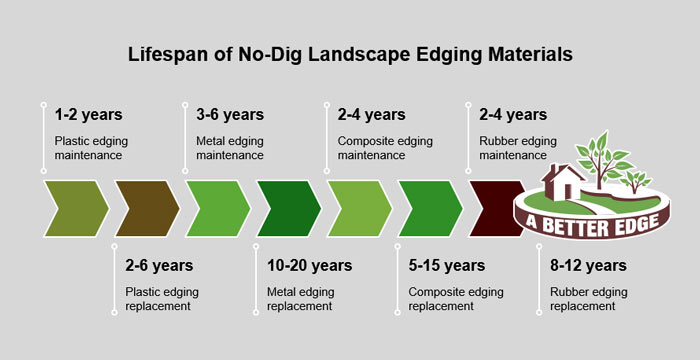
Aesthetic Limitations
While no-dig landscape edging can create clean, professional-looking borders, some limitations exist:
- There is less variety in height options compared to traditional edging
- Limited ability to create dramatic level changes
- Fewer material choices than dug-in options
- Some visibility of stakes or support systems
Cost Analysis: Is No-Dig Landscape Edging Worth the Investment?
When evaluating the value proposition of no-dig landscape edging, it’s essential to consider both material and installation costs compared to traditional options:
Material Cost Comparison
| Edging Type | Material Cost (Per Linear Foot) |
|---|---|
| Plastic | $2-7 |
| Metal | $6-14 |
| Composite | $5-12 |
| Stone/Brick (Traditional) | $16-70 |
| Concrete Curbing (Traditional) | $20-40 |
Installation Cost Consideration
The actual cost advantage of landscape edging often manifests in installation savings:
- No-dig landscape edging installation: $8-16 per linear foot
- Traditional landscape edging installation: $36-100 per linear foot for stone/brick
- Concrete curbing installation: $20-40 per linear foot
Long-Term Value Assessment
When calculating the actual value of landscape edging, consider the following:
- Initial investment: Combined materials and installation
- Maintenance requirements: Annual upkeep expenses
- Replacement frequency: How often will you need to reinstall?
- Landscape Services flexibility: Does it accommodate future changes?
For many homeowners, the lower initial investment of no-dig landscape edging makes it an attractive option, even if replacement is needed more frequently than traditional methods.
Best Applications for No-Dig Landscape Edging
No-dig landscape solutions shine in specific applications:
Garden Bed Definition
Creating clean lines between lawn areas and planting beds is perhaps the most common and successful application of no-dig landscape edging. The minimal disturbance allows for the following:
- Immediate visual impact
- Protection of existing plants
- Easy seasonal adjustments
- Clean mowing lines
Temporary Landscape Design
For homeowners considering major landscape overhauls in the future, landscape edging provides an excellent intermediate solution:
- Test design concepts before permanent installation
- Create definition while saving for premium materials
- Adjust as plants mature to determine the optimal layout
- Implement seasonal design changes
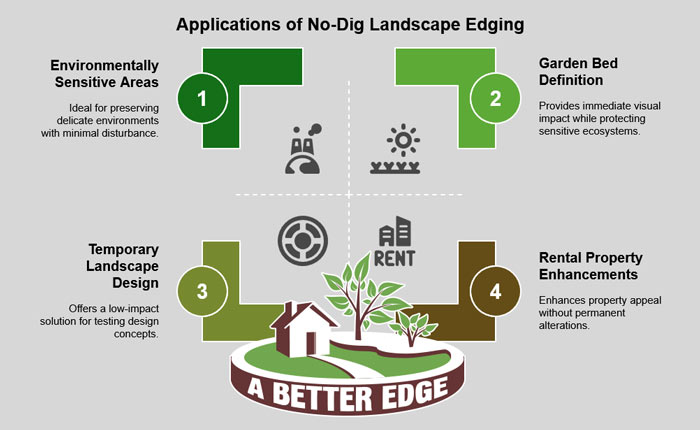
Rental Property Enhancements
For property managers or renters seeking landscape improvements:
- Install without permanent property alterations
- Remove without damage when leases end
- Create a professional appearance with minimal investment
- Easily adjust to tenant preferences
Environmentally Sensitive Areas
No-dig landscape edging is particularly valuable in the following ways:
- Native plant restoration projects
- Erosion-prone zones
- Areas with protected soil ecosystems
- Sensitive watershed regions
Professional Installation vs. DIY: What Makes Sense for No-Dig Landscape Edging?
While no-dig landscape edging is often marketed as a DIY solution, professional installation offers several advantages:
Benefits of Professional Installation
- Proper material selection: Professionals understand which no-dig systems work best for specific soil types and applications
- Consistent depth and alignment: Ensures edges remain straight and level
- Appropriate staking: Correct stake placement is crucial for longevity
- Design expertise: Professional landscape services can integrate edging with overall design elements
- Time efficiency: What might take a homeowner a weekend can often be completed in hours by professionals
When DIY Makes Sense
DIY installation of no-dig landscape edging may be appropriate when:
- You have experience with landscape installations
- The project is small in scope (under 100 linear feet)
- The terrain is relatively flat, and even
- Soil conditions are favorable (loamy, free of large rocks)
- You’re working with high-quality materials designed for simple installation
Maintenance Requirements for No-Dig Landscape Edging
To maximize the lifespan of your no-dig landscape edging, regular maintenance is essential:
Seasonal Checks
- Spring assessment: Check for frost heave and realign as needed
- Summer inspection: Ensure edging remains secure during peak growth
- Fall cleanup: Remove debris that could cause displacement
- Winter preparation: Address any weakened areas before freeze-thaw cycles
Common Maintenance Tasks
- Restocking loose sections
- Realigning shifted pieces
- Cleaning accumulated debris
- Trimming encroaching plants
- Replacing damaged sections
Professional landscape services often include maintenance packages for no-dig edging that ensure long-term performance and appearance.
Innovations in No-Dig Landscape Edging
The landscape industry continues to evolve, with several innovations improving no-dig options:
Advanced Materials
Newer landscape edging products feature:
- UV-resistant polymers for extended lifespan
- Composite materials that combine flexibility with durability
- Recycled content that enhances sustainability
- Hybrid systems that incorporate traditional stability with no-dig convenience
Improved Design Features
Modern no-dig landscape edging often includes:
- Interlocking components for more excellent stability
- Enhanced stake designs for better soil grip
- Camouflaged connection points for cleaner aesthetics
- Modular systems that allow for expansion
These innovations have significantly improved the performance and appearance of no-dig landscape options, making them increasingly competitive with traditional methods.
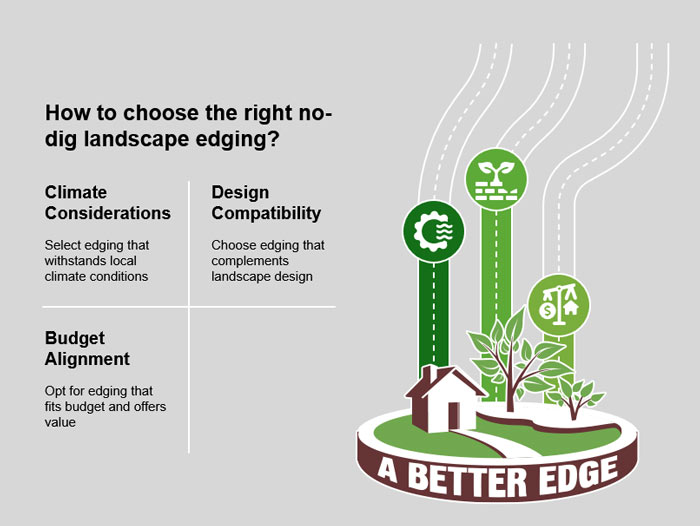
Choosing the Right No-Dig Landscape Edging for Your Project
With numerous options available, selecting the appropriate no-dig landscape edging requires consideration of several factors:
Climate Considerations
Your local climate significantly impacts which no-dig edging will perform best:
- Freeze-thaw cycles: In areas with significant temperature fluctuations, more flexible materials prevent cracking
- High heat regions: UV-resistant materials prevent degradation and warping
- High precipitation areas: Consider options with enhanced drainage features
- Arid environments: Look for materials that won’t become brittle in dry conditions
Design Compatibility
The proper no-dig landscape edging should complement your overall landscape design:
- Modern landscapes: Sleek metal edging creates clean lines
- Natural gardens: Lower-profile, earth-toned options blend with organic elements
- Formal designs: Consider options that mimic traditional materials
- Child-friendly spaces: Rubber edging provides safety while maintaining appearance
Budget Alignment
Finding the right balance between initial investment and long-term value:
- Budget-conscious: Plastic no-dig options provide immediate definition at a lower cost
- Mid-range investment: Composite systems offer better durability with a moderate price increase
- Premium appearance: Metal no-dig edging delivers professional results with a longer lifespan
- Maximum value: Professional landscape services can recommend the optimal balance of materials and installation for your specific situation
Conclusion: Making the Right Choice for Your Landscape
No-dig landscape edging represents a valuable innovation in landscaping, offering a balance of convenience, affordability, and functionality. While it may not be the perfect solution for every application, it provides distinct advantages for many residential and commercial projects.
When evaluating whether no-dig landscape edging is worth it for your specific needs, consider the following:
- The specific requirements of your landscape design
- The soil conditions and climate of your property
- Your budget constraints for both materials and installation
- How long do you intend to maintain the current landscape design
- Whether you’ll tackle installation yourself or hire professional landscape services
For many homeowners, the reduced installation time, minimal disruption to existing plantings, and lower initial cost make no-dig landscape edging an excellent choice. By working with knowledgeable landscape services providers who understand these systems’ strengths and limitations, you can achieve professional results that enhance your property’s beauty and functionality.
At A Better Edge, we’re committed to helping you navigate these choices with transparent information about all edging options. Whether you select landscape edging or traditional installation methods, we aim to ensure your landscape reaches its full potential.
More info regarding Prohibit Landscaping Practices for Water Conservation: SB24-005.




